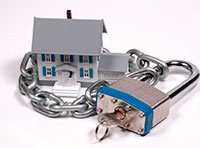
Home Safety and Security
Step 1: Join Neighbourhood Watch
If you are not an online member of Neighbourhood Watch, you may like to join and receive emails updates about crime in our local area. Or ’Like’ Tweed Byron LAC on Facebook. You might also like to check out Project “eyewatch” – NSW Police Force on Facebook If you are already an online member, you may like to consider becoming a street representative. Maybe ask your neighbours to do the same – your neighbours are your most
valuable security asset.
Step 2: Marking of valuables
The engraving of your driver’s licence number on household property is strongly recommended. Engrave the letters NSW before the numbers to indicate your location. When the engraved item is sold or disposed of, engrave the letter “S” after your driver’s licence number to indicate change of ownership.
To obtain an engraver please contact your local crime prevention officer.
Step 3: Trees and shrubs
Your trees and shrubs should be trimmed to allow a clear view of your house. This will remove hiding places for the “would be” offender and improve your neighbour’s visibility should you need assistance.
Step 4: Backyard security
Ensure that you have fences or other barriers at either side of your home. This will make it more difficult for an offender to enter and work in the “safety” of your backyard. Also ensure that all tools are stored away and outbuildings are locked securely.
Step 5: Lighting
Good lighting, such as flood lamps, should be installed to minimise hiding spots for the “would be” offender, particularly while you are at home. “Motion sensor” or “reactive” lighting is excellent for this and is quite inexpensive to buy and install.
Step 6: Protect your power supply
Apply to your power company for an approved padlock or key lock to be installed. Circuit breaker switches installed within the home are also an advantage, but the meter box must still be locked.
Step 7: Door locks
Have door locks fitted without delay. Normal key in the knob locks, which are fitted to most homes, are a burglar’s delight. These locks must be backed up with a security lock. Fit a key operated lock (commonly referred to as a patio door bolt) to aluminium sliding doors. Do not rely upon manufacturer fitted locks or catches.
Step 8: Window locks
Windows that are not fitted with key operated locks are an easy target for offenders, and will offer little or no resistance. Key operated locks provide a much greater level of security than manufacturer fitted catches, there is a lock for every type of window. Remember, do not leave the keys in the locks.
Step 9: Security screens and doors
Have security screens fitted to the doors or portion of the windows that are left open for ventilation. This will prevent an offender from “walking in” on you. Remember, although security screens and doors increase your security, they are for use when you are at home. Ensure the doors are “key locked” as the latch (snib) device on many doors does not achieve maximum security.
Step 10: Alarms
Consider the installation of an Australian Standard 2201 approved burglar alarm. Intruders are far less likely to break into a house with an alarm system. An alarm will usually only tell you after an offender has entered your home. For immediate response to an alarm, the use of a monitoring service will make arrangements for your premises to be checked. All security products should be installed by licensed security installers.
Step 11: YOUR WALLET / PURSE
The contents of your wallet contain an enormous amount of personal information that criminals can use to gain access to your bank accounts, create false identities and run up huge expenses on your credit cards. The cost and inconvenience, which results from lost or stolen wallets containing this high level of personal information, is enormous. However, there are some precautions that can be taken by anyone to ensure that, should your wallet be stolen or lost, you can take action promptly and the information contained within it is less likely to be used for criminal gain.
- Keep a copy of the personal information (driver’s licence, Medicare card, EFTPOS cards, etc) and credit card details contained in your wallet. This can be done quite simply by photocopying this material and storing these photocopies in a secure place (other than your wallet).
- Should your wallet be lost or stolen, report that loss immediately to the police within the jurisdiction in which it was lost/stolen. Prompt and timely reporting of the loss will aid any police investigation.
- Your credit card provider(s) also will need to be contacted promptly and advised as to which other personal information (such as your driver’s licence or passport) was lost/stolen along with the credit card(s). A fraud alert will be issued against the card. This prompt advice will mean that thieves are greatly restricted in the fraudulent use of this personal information to purchase goods, as credit card identity verification, to apply for credit, or to withdraw cash against your card.
Sourced from Banora Point Flame Tree Park March 2013 Newsletter.
